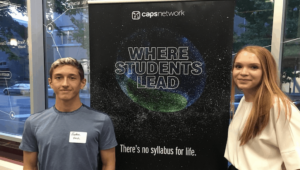Networks, Platforms, & Procurement

Schools in a network share a common mission, pedagogical approach, measurement system, structure, schedule and staffing strategy. Networks are usually horizontal (i.e., same school model and support system), but the concept could be applied to a vertical feeder pattern (e.g.,ReynoldsburgeSTEM) or a small district (e.g.,Mooresville). I use the term enterprise to describe districts or networks that operate with the same model, platform, and device.
To rapidly improve the quality of urban options, cities should take a portfolio approach –improving schools and adding new options. In most cases, school improvement and new school development should be approached in networks.
In the remainder of this post, I’ll try to make four points: 1) schools should join networks, 2) networks should be platform-centric, 3) networks should exercise smart procurement, and 4) states and districts should encourage robust networks. Here’s how and why.
1. Schools should join networks. Some principals are good at supporting consistently great teaching classroom by classroom. A few school leaders are great at design thinking. Few are good at both. Designing, building, and sustaining a great school around an intellectual mission requires extraordinary skill and perseverance.
School networks (e.g., charter management organizations and school developers like New Tech Network) have demonstrated potential for high performance and scalability. Many networks have become innovation engines (e.g. Aspire, Summit, Leadership, Michigan’s Education Achievement Authority) co-developing platforms that complement new school models.
School districts are subject to the whims of oscillating political leadership. Nonprofit school networks have perpetual mission-focused leadership that gives them a shot at sustaining mission-focused coherence over time. With an autonomy agreement, that ‘air cover’ can even extend to a district school (like many New Tech, Big Picture, or Expeditionary Learning schools). Most schools have a better chance of achieving and sustaining high performance by joining a network.
Dynamic networks create “network effects,” they get better and more valuable as they grow. Networks can provide “powerful collaboration opportunities for teachers and administrators outside the “normal” silos found within a district or site-based governance structure,” said Lydia Dobyns, New Tech Network CEO, “The more we can transform instructional practices from “closed fortress” to open, connected and transparent practices the more effective the teaching and learning.”
Dobyns adds that “establishing a ‘shared’ or ‘distributed’ leadership at the building level is greatly facilitated through network affiliation.” New Tech is working to redefine role of principal and teacher to build and sustain a learning organization framework driven by data. “Moving the school focus to student outcomes, using qualitative and quantitative data creates deep ownership and has the side benefit of bringing the joy back to teaching and being an administrator,” said Dobyns.
2. Networks should be platform-centric. Good schools are coherent–everything works together for kids and teachers. This is even more the case with the shift to digital. Blended learning is a team sport enabling new learning opportunities for students and extended reach opportunities for teachers.
Over the next few years, most schools in the U.S. will shift to predominantly digital instructional materials with Internet access devices for every student. As described in the Blended Learning Implementation Guide, the shift opens up a world of possibility but the new environment requires a complex sequence of decisions about goals, school models, platforms, devices, and staffing–these decisions warrant consideration at the district or network level.
Networks should adopt a common information technology stack (to the extent possible) including student information, content management, productivity tools, social learning, assessment and data, and student access devices. It’s hard enough for a network to make this series of decisions and try to get this stuff to work together, it just doesn’t make sense for every school to build a custom IT stack.
Some of the CEE-Trust partners (30 local partners committed to portfolio strategy) are discussing the potential for a model-neutral CMO structure as a vehicle for linking stand-alone schools that want to preserve their cultures but join a network that provides back office services (e.g., Chicago International). It’s easy to imagine this sort of structure extending to the IT stack and other support services.
3. Networks should exercise smart procurement. Networks should use a combination of smart procurement and selective internal development to offer schools in their network access to attractive pricing on integrated products and services.
With help from Daniel Owens, The Learning Accelerator, following are eight procurement strategies to add value across a network:
-
Identify common sources of pre-arranged contracts (state contracts, purchasing consortia) for potential time-savings as well;
-
Networks should identify common spends at common times and leverage strategic procurement to save time and money (volume discounts, single delivery, etc.).
-
Use a Request for Proposal (RFP) to consider software, hardware, and support bundles;
-
Think twice before trying to develop or customize a platform even with a capable partner–it will take longer and cost more than you think;
-
Build multi-tiered technical support services including self-help, online, phone, and onsite (e.g., Maine built in tiered support in their laptop RFP);
-
Support teacher development plans (with a platform partner like Bloomboard) with on-demand and team-based resources and network-wide professional learning communities;
-
Work with an online learning provider to leverage teacher talent and expand access to electives (see New Tech example) as well as advanced courses (see 10 strategies for boosting AP completion rates ); and
-
Work with an online special needs partner like PresenceLearning to improve effciency and effectiveness of service delivery.
4. States and districts should encourage robust networks. As noted in the Smart Cities series, “portfolio is the only path” for America’s great urban centers–a blend of improvement and new school development. School networks–both CMOs and school developers–are key to rapidly boosting access to quality options.In a recent school finance white paper, we argued that states and districts should push a higher percentage of funding to schools in weighted flexible block of funds. A number of us tried this 20 years ago and found that the autonomy/accountability model didn’t work if there wasn’t capacity at the school level to use it effectively. States and districts could make available this bundle of autonomy and flexible funding to schools that join a network or, through application and performance, demonstrate readiness to operate with more independence.
Compared to blanketing LA with iPads, I suggested to Myles Mendoza last week that this approach could be used in a city like Chicago to create incentives for schools to join one of 6-8 platform-centric networks over the next few years. Each of these networks would have a school model, common support services and a common IT stack. For example:
- Competency-based K-8 using open content and apps on Edmodo with iPads
- Challenge-based secondary using Compass on Brainhoney with Chromebooks
- High school flex model using K12 on HP desktops
- New Tech PBL STEM on Echo with Microsoft Surface
Incentives and authorization strategies could be used to ensure that every family in Chicago had access to an interesting and appropriate array of options.
The shift to personal digital learning holds great promise, but it is a complicated path. Most schools will benefit from navigating the digital shift as part of a high capacity network.
PresenceLearning is a Getting Smart Advocacy Partner. BloomBoard is a Learn Capital portfolio company where Tom Vander Ark is a partner.






Renee
I take a different point of view. Conforming around a platform artificially limits the connections that schools CAN have. If they were to align around approach to learning and selection of learning tasks, etc the platforms would be those that are selected by the learner.